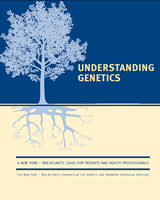All Genetic Alliance content, except where otherwise noted, is licensed under a Creative Commons Attribution License, which permits unrestricted use, distribution, and reproduction in any medium, provided the original work is properly cited.
NCBI Bookshelf. A service of the National Library of Medicine, National Institutes of Health.
Genetic Alliance; The New York-Mid-Atlantic Consortium for Genetic and Newborn Screening Services. Understanding Genetics: A New York, Mid-Atlantic Guide for Patients and Health Professionals. Washington (DC): Genetic Alliance; 2009 Jul 8.

Understanding Genetics: A New York, Mid-Atlantic Guide for Patients and Health Professionals.
Show detailsGenetic Testing Methodologies
As the number of genetic tests has expanded rapidly over the last decade, so have the different types of genetic testing methodologies used. The type of test employed depends on the type of abnormality being measured. In general, three categories of genetic testing—cytogenetic, biochemical, and molecular—are available to detect abnormalities in chromosome structure, protein function, and DNA sequence, respectively.
Cytogenetic Testing
Cytogenetics involves the examination of chromosomes to identify structural abnormalities. Chromosomes of a dividing human cell can be analyzed clearly in white blood cells, specifically T lymphocytes, which are easily collected from blood. Cells from other tissues such as bone marrow, amniotic fluid, and other tissues can also be cultured for cytogenetic analysis. Following several days of cell culture, chromosomes are fixed, spread on microscope slides, and stained. The staining methods for routine analysis allow each of the chromosomes to be individually identified. The distinct bands of each chromosome revealed by staining allow for analysis of the chromosomal structure.
Fluorescent in situ hybridization (FISH) is a process that vividly paints chromosomes or portions of chromosomes with fluorescent molecules to identify chromosomal abnormalities (e.g., insertions, deletions, translocations, and amplifications). FISH is commonly used to identify specific chromosomal deletions associated with pediatric syndromes such as DiGeorge syndrome (a deletion of part of chromosome 22, also called del22) and cancers such as chronic myelogenous leukemia (a translocation involving chromosomes 9 and 22).
Biochemical Testing
Clinical testing for a biochemical disease utilizes techniques that examine the protein instead of the gene. Many biochemical genetic diseases are known as “inborn errors of metabolism” because they are present at birth and disrupt a key metabolic pathway. Depending on the disease, tests can be developed to directly measure protein activity (direct measurement of enzyme activity), level of metabolites (indirect measurement of enzyme activity), and the size or quantity of protein (protein structure). These tests require a tissue sample in which the protein is present, typically blood, urine, amniotic fluid, or cerebrospinal fluid. Because gene products may be more unstable than DNA or RNA and can degrade quickly, the sample must be collected, stored properly, and shipped promptly according to the laboratory’s specifications.
A variety of technologies such as high performance liquid chromatography (HPLC), gas chromatography/mass spectrometry (GC/MS), and tandem mass spectrometry (MS/MS) enable both qualitative detection and quantitative determination of metabolites. In addition, bioassays may employ flourometric, radioisotopic, or thin-layer chromatography methods.
Molecular Testing
Direct DNA analysis is applicable when the gene sequence of interest is known. For small DNA mutations, direct DNA testing is typically the most effective method, particularly if the function of the protein is unknown and a biochemical test cannot be developed. A DNA test can be performed on any tissue sample and requires very small amounts of sample. Several different molecular technologies, including direct sequencing, polymerase chain reaction-based assays (PCR), and hybridization, can be used to perform testing. PCR is a common procedure used to amplify targeted segments of DNA through repeated cycles of denaturation (heat-induced separation of double-stranded DNA), annealing (binding of specific primers of the target segment to parent DNA strand), and elongation (extension of the primer sequences to form a new copy of the target sequence). The amplified product can then be further tested. For some genetic diseases, many different mutations can occur in the same gene and result in the disease, making molecular testing challenging. However, if the majority of cases of a particular genetic disease are caused by a few mutations, this group of mutations is first tested before more comprehensive testing such as sequencing is performed.
Comparative genomic hybridization (CGH) or chromosomal microarray analysis (CMA) is a molecular cytogenetic method for analyzing gains or losses in DNA that are not detectable with routine chromosome analysis. The method is based on the proportion of fluorescently-labeled patient DNA to normal-reference DNA. CGH can detect small deletions and duplications, but not structural chromosomal changes such as balanced reciprocal translocations or inversions or changes in chromosomal copy number.
DNA microarray analysis, also referred to as gene, genome, or DNA chip analysis, is a tool for determining gene expression. Molecules of mRNA bind, or hybridize, specifically to a DNA template, typically a gene or portion of a gene, from which it originated. When an array contains many DNA templates, the expression level of hundreds to thousands of genes from an individual patient sample can be measured using a computer to detect the amount of mRNA bound to each site on the array.
Protein microarray analysis is used to quantify the amount of protein present in biological samples. Similar to chromosome and DNA microarray analysis, the hybridization of labeled target proteins in a patient sample is measured against a reference sample. Also referred to as a biomarker, the presence, absence, increase, or decease of a particular protein can be an indicator of disease in a person. For example, analysis of the cerebrospinal fluid of a patient for amyloid beta or tau proteins may be used to diagnose Alzheimer’s disease.
References
- Greenwood Genetic Center. Cytogenetics: Chromosome Analysis. www.ggc.org/diagnostics/cytogenetics/cytogenetics.htm.
- Laboratory Corporation of America. A Basic Guide to Genetic Testing. www.labcorp.com/genetics/basic_guide/index.html.
Resource
- GeneTests www.genetests.org.
- GENETIC TESTING METHODOLOGIES - Understanding GeneticsGENETIC TESTING METHODOLOGIES - Understanding Genetics
Your browsing activity is empty.
Activity recording is turned off.
See more...